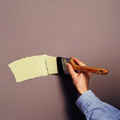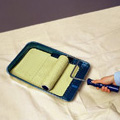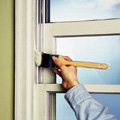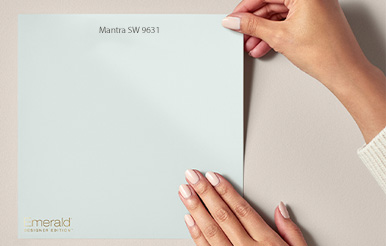Using good painting techniques is key to achieving professional-looking results. Another tip is to use enough paint. Get into the habit of going to the paint can often. Let the paint do the work, and you'll save time and get the finish you want.

Using a Brush
Hold a brush near the base of the handle.
Dip half the bristles into the paint and tap on the lip of the can. Don't wipe it on the side.
Paint with enough pressure to bend the bristles slightly — don't bear hard on the brush.
A 1"-2" brush offers good control so it is well-suited for detail work such as cutting in around windows or painting molding. To apply paint to larger surfaces such as doors, use a 3"-4" brush.

Using a Roller
Roll the roller slowly into the paint in the tray. Then, roll it back and forth until roller cover is evenly coated with paint.
Roll onto the tray's ridges to remove excess paint.
For smooth surfaces: Cover about a two-foot-square using the N pattern shown. Cross roll to spread the paint. Finish, with light roller strokes in one direction, at a right angle to the cross roll.
If the surface you are painting is porous or textured, use a heavy-nap roller cover (1/2" or more). Use a 1/4" nap to maximize sheen on a smoother surface.

Painting Double-Hung Windows
For double-hung windows move each sash to the center of its track and paint the inside sash, starting with the crossbars. Then, paint the frame. Don't paint the top edge of the inside sash; you'll use it to move the sash. Next, paint the top half of the outside sash, starting with the crossbar, then the frame.
Close the sashes to within several inches of the closed position. Paint the rest of the outer sash and the top edge of the inner sash. Paint the window casing, then the sill.
Paint the check rails. Move both sashes down as far as they will go, then paint the upper rails. Once the paint is thoroughly dry, move both sashes up and paint the lower rails of the window.


Casement or Awning Windows
Open the windows and paint the top, side and bottom edges.
Finish with the crossbars, frame, casings and the sills.
Paneled Doors
First remove all hardware or cover it with masking tape. If paint does get on metal parts, wipe it up immediately with a soft cloth.
Start by painting the panels, working from top to bottom. For each panel, paint panel molding first, then the interior, using up and down strokes with your brush.
Next, paint the rest of the door, finishing with the outer edges. If the door swings out, paint the hinged edge. If the door swings in, paint the lock-side edge.
Flush Doors
Paint the edges first.
Then fill in the center area, working from top to bottom.
Finish with the frame and jamb.










